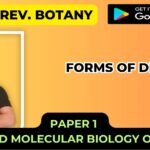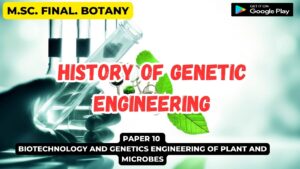![]()
TRANSCRIPTION
- The production of RNA copies from a DNA template is known as transcription.
- It is catalyzed by a specific enzyme RNA polymerase or transcriptase.
- During this process, only one strand of DNA duplex is known as template strand or antisense strand.
- This results in the production of m-RNA molecules having a base sequence complementary to the template DNA strand.
- It should be noted here that the sense. strand or coding strand of DNA is now copied and has the same base sequence as the RNA produced by the antisense strand.
- The RNA polymerase is a complex enzyme and usually consists of a larger protein part (apoenzyme), which is known as core enzyme and a cofactor, which is known as sigma factor.
- The two combine to produce the complete enzyme of holoenzyme.
- Unless and until the two parts of RNA polymerase do not combine with each other, it is not functional.
- As far as the nature of RNA polymerase in prokaryotes and eukaryotes is concerned, it shows much diversity.
- While in prokaryotes like E.coli a single species of this enzyme is found, at least three distinct RNA polymerases have been reported in nuclei of most eukaryotes.
- These have been named as :
- RNA polymerase-I or A,
- RNA polymerase-II or B and
- RNA Polymerase-III or C.
- They have different functions as:
RNA polymerase-I or A:
- It is located in the nucleolus and responsible for the synthesis of rRNA.
RNA polymerase-II or B:
- It is found in the nucleoplasm and is responsible for the synthesis of hnRNA which is a precursor of mRNA.
RNA polymerase-III or C:
- It is also found in the nucleoplasm. It is responsible for the production of 5s rRNA and tRNA.
Promoters for RNA Polymerase II The transcription unit
- A transcription unit is a stretch of DNA that codes for an RNA molecule and the sequences necessary for its transcription.
- Within a transcription unit are three critical regions:
- a Promoter ,
- a RNA-coding Region, and
- a Transcription Termination Site.
- The promoter is a DNA sequence that the transcription apparatus recognizes and binds.
- Transcription apparatus comprises RNA polymerase and certain proteins (known as Transcription Factors) which help transcription.
- The promoter indicates which of the two DNA strands is to be read as the template and the direction of transcription.
- It also determines the transcription start site, the first nucleotide that will be transcribed into RNA.
- In most transcription units, the promoter is located next to the transcription start site but is not, itself, transcribed.

- 2. The second critical region of the transcription unit is the RNA-coding region, a sequence of DNA nucleotides that is copied into an RNA molecule.
- 3. The third component of the transcription unit is the Transcription
- Termination Site, a sequence of nucleotides that signals where transcription is to end.
- These sites are also called Terminators.
- The Terminators are well defined in prokaryotic genomes but not so in Eukaryotes.
GENERAL FEATURES of TRANSCRIPTION
- Broadly, the process appears to be similar to DNA replication, where one DNA strand acts as a template for the 5’3′ directed synthesis of a complementary strand.
- However, a profound difference lies in the chemical nature of the complementary molecule.
- In transcription, it is RNA. Hence, instead of deoxyribonucleotides, ribonucleotides are found. Moreover, Thymine is replaced by Uracil.
- During Transcription in any given region, only one DNA strand is used as template, while in replication both the strands of parent DNA molecule act as template.
- RNA chain synthesis does not require any primer; it can start de novo.
- The reaction is catalyzed by enzymes called RNA polymerases.
- For the RNA synthesis, the polymerases need ribonucleotide triphosphates [rNTPs].
- This is a similarity with DNA polymerases.
- RNA Polymerases can initiate transcription only at specific nucleotide sequences.
- Such nucleotide sequences are designated as promoter sequences.
- Therefore, promoter sites are the locations on the DNA molecule where transcription begins.
- RNA polymerases are also capable of opening the DNA double helix locally.
- Hence, there is no need for helicases.
- Moreover, as transcription proceeds the same polymerase reseals the double strand too. By this mechanism, generation of torsion is avoided.
- The locally unwound site of a DNA molecule is called a transcription bubble.
- The process of transcription can also be subdivided into three stages:
- A. Initiation
- B. Elongation
- C. Termination
- Molecular biologists often use the terms upstream and downstream to refer to the direction of transcription and the location of nucleotide sequences surrounding the RNA- coding sequence.
- The transcription apparatus is said to move downstream during transcription; it binds to the promoter (which is usually upstream of the start site) and moves toward the terminator (which is downstream of the start site).
Promoter, enhancer and silencer sites for initiation of transcription in eukaryotes
- In eukaryotes there are three RNA polymerases:
RNA polymerase I or RNAPI
- for synthesis of pre-rRNA;
RNA polymerase II or RNAPII
- for synthesis of re-mRNA or hnRNA and several snRNAs, and
RNA polymerase III or RNAPIII
- for synthesis of 5S RNA, tRNA.
- Different promoter sequences have been identified for different RNA polymerases.
Transcription in prokaryotes
- Transcription in Bacteria can be conveniently divided into three stages:
Initiation,
- Initiation of transcription begins at the promoter, the region where the transcription enzyme RNA polymerase binds the DNA.
- The promoters are usually located on the upstream of the genes to be transcribed.
- The promoters of the prokaryotes differ in their sequences, though there are two conserved sequences observed.
- These two sequences are located approximately 10 and 35 base pairs upstream of the transcription start site.
- The transcription start point, which the first base transcribed is termed the +1 site or the initiation site.
- The region on the upstream of this initiation site is denoted by a negative (-) sign and the ones on the downstream are denoted by a positive (+) sign.

- Hence the conserved upstream sites are referred to as -10 and -35 regions.
- The -10 region has the conserved sequence of TATAAT and the -35 region has TTGACA sequence
- The σ subunit of RNA polymerase (RNA pol) binds specifically to both, the -35 and -10 regions, and loads the RNA pol onto the promoter.
- The binding of the RNA pol to the promoter results in formation of a closed-promoter complex.
- The RNA pol then interacts with the DNA and unwinds around a 15 bases long region at the initiation site to create a transcription bubble, collectively called open-promoter complex.
- As the initiation site unwinds, single-stranded DNA is exposed and can be used as a template for transcription .
- The strand which is transcribed is known as the template strand or antisense strand.
- The other strand is called as coding strand or sense strand
- RNA pol initially initiates abortive transcription, wherein short cycles of synthesis and release of short RNA transcripts of approximately 10 nucleotides take place till RNA polymerase-promoter initial transcribing complex leaves the promoter.
- The RNA pol escapes the promoter and initiates productive synthesis of RNA, forming RNA polymerase-DNA elongation complex

2. Elongation:
- RNA polymerase-DNA elongation complex is stable and processive.
- It carries out transcription on an average rate of 30 – 100 nucleotide/sec.
- RNA polymerase is the principle protein, which adds the nucleotides.
- In most prokaryotes, a single type of RNA pol transcribe all types of RNA.
- The core RNA pol is made up of 5 subunits, which are conserved in prokaryotes as well as eukaryotes.
- Prokaryotic core enzyme consists of two copies of α, one copy of each- β, β’, and ω subunits.
- The core enzyme can bind the template DNA and synthesize RNA.
- σ factor binds the core enzyme to form the holoenzyme and helps in recognising the promoter.
- α subunit interacts with various transcription factors and helps regulate transcription.
- It also has DNA binding site with help of which it binds upstream promoter DNA.
- The RNA pol has two α subunits forming a homodimer which binds β and β’ subunits.
- β and β’ subunits are the largest subunits which form the catalytic center of RNA synthesis and have binding sites for double-stranded downstream DNA, DNA/RNA hybrid and RNA.
- The ω subunit has been linked recently with RNA pol stability and specificity
- σ factor associates with the core enzyme for promoter recognition and it dissociates from the core enzyme once RNA pol starts processive RNA synthesis.
- RNA pol catalyzes the polymerization of ribonucleoside 5′-triphosphates (NTPs) using the DNA as template.
- The ribonucleoside triphosphates are added to the 3′ end, i.e. mRNA synthesis takes place in the 5′ to 3′ direction.
- This extension of RNA chain occurs de novo and doesn’t need a primer.
- In prokaryotes, the genomic DNA usually contain no introns and the transcript synthesized may contain information for more than one protein.
- Such transcripts are called as polycistronic mRNA.

3. Termination:
- The transcription has to be terminated to release the newly synthesized mRNA.
- The termination is brought about by two different mechanism, one is rho independent or RNA-based and the other is rho dependent or protein-based.
Rho independent or RNA based:
- RNA based termination employs intrinsic (in RNA structure itself) terminators having two structural features, GC-rich inverted repeat with several intervening nucleotides, followed by a stretch of U residues in the transcribed RNA.
- When the GC-rich inverted repeats are transcribed, the RNA regions with self complementary sequences base-pair with one another and form a stem-loop structure .
- This stem-loop structure interacts with the RNA polymerase and causes it to pause.
- The following stretch of U residues at the 3′ end of the transcript, which are weakly base-paired with the A residues of the template DNA, create a very unstable region.
- The stem loop followed by the weakly bond stretch together leads to the release of the RNA transcript from the transcription complex.

Rho dependent or protein-based:
- This mechanism was first recognized in λ-phage DNA.
- It involves a protein called Rho factor, which is a hexameric protein.
- Rho is a RNA/DNA helicase or translocase, that causes dissociation of RNA pol from DNA template and releases RNA. It also has ATPase region.
- In rho dependent termination, there are specific sites, transcribed called the rho–dependent terminators.
- These contain two separate sites; a rho utilization site called the ‘rut site’ and a downstream transcription stop point also called as ‘tsp site’
- Rho binds RNA at the transcribed ‘rut site’ region.

- This binding activates RNA-dependent ATPase activity of Rho.
- Rho moves along the RNA till it reached the RNA pol.
- The energy derived from the hydrolysis of ATP is used by the rho, with helicase activity, to unwind RNA-DNA hybrid from RNA pol and results into termination
- In prokaryotes, protein synthesis or the translation starts simultaneously with the transcription, while the mRNA is still being synthesized.
- This is possible due to the lack of nucleus or any type of compartmentalisation.
- Hence, the transcript is immediately translated to synthesize the corresponding protein.






